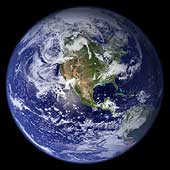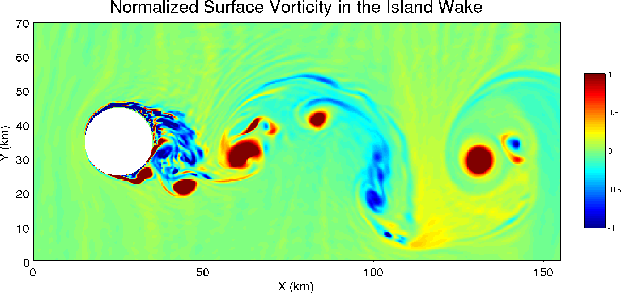Vorticity Generation in Island Wakes
The figure below shows eddy generation in a lab experiment. The experiment
is one of a series of lab experiments conducted in November, 2008.
The laboratory experimental project “Three Dimensional Vortex Street
Instability at High Reynolds Number
around IslandS” (TIRIS),
funded by the 6th
European Commission (EC) Framework Program Hydralab III,
was
conducted on the largest rotating tank in the world, the
Coriolis Platform (13m diameter), located at
Laboratoire des
Ecoulements Géophysiques et Industriels (LEGI) in
Grenoble, France, in November, 2008.
I participated in the project, led by Dr. Rui Caldeira from Portugal and Dr. Alex
Stegner from France.
A continuous effort for interesting lab data processing and numerical reproduction of the lab experiments
are being supported by the ONR, in collaboration with Drs. Rui Caldeira (Portugal) and Alex Stegner (France).

Oceanic Island wakes includes two aspects:
A. Oceanic response to wind wakes
When wind blows past an island, in the lee side of
the island, the wind intensity drops. There are two immediate effects
on ocean: weak mixing
and wind shear at two edges of the island. The former one may introduce
a warmer water in lee side of the island relative to the adjacent
area; and the latter one causes the Ekman pumping.
B. Oceanic current past an island(s)
With the rotating and stratified oceanic flow past
an island(s), the vortex can be generated through three different
mechanims: lateral boundary,
bottom boundary and the barolcinic tilting. Three mechanims can be
categorized into two types: deep water and shallow water. Centrifugal,
barotropic
and baroclinic instability could be involved in the eddy generation and evolution.
With its round shape and sharp shelf slope, Gran Canaria Island (Spain) is an idealized laboratory to study island wakes.
The study is collaborated with Dr. Pablo Sangra.
With the existence of eight substantial islands, Southern
California Bight is also a nice field experiment to study island wakes.
A rotating and stratified flow past an cylinder-like island (example: Gran Canaria, Spain)
Current Researches:
- Island wakes and their environmental impact.
- High-resolution realistic simulation
- Southern California Bight Circulation and Forecast System
- Bering Sea Ice-Ecological-coupled System
- Sediment Transport
- Pollution (such as DDTs) Dispersion Water Quality Assessment
 Welcome to Changming Dong's Research Website
Welcome to Changming Dong's Research Website 
 Welcome to Changming Dong's Research Website
Welcome to Changming Dong's Research Website 

